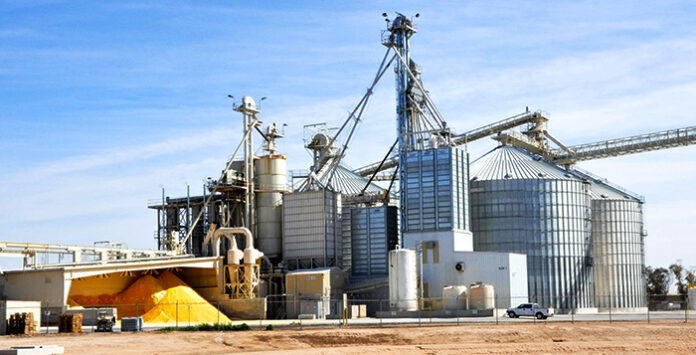
Ever wonder what that manufacturing monstrosity on Maricopa-Casa Grande Highway is? It is Pinal Energy, the state of Arizona’s lone ethanol plant.
Pinal Energy opened for production in 2007. In February 2013 it temporarily shut down due to an oversupply of ethanol in the market.
The plant re-opened for full production in April and produces about 50 million gallons of ethanol annually.
The fuel-grade ethanol blends with gasoline components to produce E10, a 10 percent ethanol blend for vehicles. The ethanol produced at the plant is also used for blending E85, a clean-burning blend of 85 percent ethanol and 15 percent gasoline that can be used in flex-fuel vehicles.
E85 gas prices are about 20 percent cheaper than regular unleaded gas prices, according to E85prices.com.
The plant has 42 employees, almost all of whom live in Maricopa or Casa Grande, said General Manager Keith Kor.
“It’s best to hire local people,” Kor says. “They have their family here, and they want to stay here.”
“We chose Maricopa as our location for the plant for its unique position as being in close proximity to the largest railroad receiving facility in the state, feed lots and dairies, and the Phoenix market,” says Tod Dickey, vice president of VMI Holdings, which owns the plant.
It operates 24/7, 350 days a year. The plant shuts down for cleaning 15 days annually.
Eighteen million bushels of corn are shipped annually on a train from the Midwest to a tank at the Pinal Energy plant. It is then ground into flour. Water and other enzymes are added to cool it. It ferments for 60 hours; alcohol is distilled and converted into unleaded gas. The process basically converts starch to sugar and then to ethanol.
The corn-based byproduct of the process is run through a centrifuge and fed to cattle.
“There is a 130 percent higher protein level in our byproduct than in the corn that feeders would feed cattle,” Dickey says. “We feed 60 percent of the state’s cattle with our byproduct.”
The CO2 produced is recycled and used to make dry ice for soft drink companies and meat-packing plants.
Dickey says the plant provides 60 percent of the state’s CO2 needs.
“We also produce about a million gallons of beer a day before it is turned into ethanol, which would make us the largest brewery in the state,” Dickey joked.
Almost all Ethanol plants in the U.S. are located in the Midwest where a large portion of the corn is grown. Arizona is one of the last states to adopt higher-blend standards, and the political climate has always been anti-ethanol, which can make things tough, Dickey says.
One of the reasons the plant shut down for a year and a half was a higher rate it paid because ethanol was not designated as a bio fuel.
This changed with the passing of Senate Bill 1413, which exempts bio fuels and electricity used for manufacturing from a state sales tax. The bill was signed into law by Gov. Jan Brewer on April 11.
“The city of Maricopa wrote a letter in support of our efforts for SB1413, which placed us in the bio-fuel community,” Dickey says.
“Not enough of the folks at the Legislature understand the economic impact of the grain and agricultural industry in Arizona,” says Robert Shuler, a lawyer and lobbyist for Pinal Energy.
“Having an ethanol plant in Arizona has a $92 million economic impact to the state a year,” Dickey says. “There is no real economic impact when our alternative fuels come from the Midwest.”
The plant is also a zero-discharge facility, which means all of the water is recycled and used again, according to Plant Manager Matt Rynearson. The other byproducts of the process of turning the corn into ethanol are used as feed for livestock and as CO2 for bottling and dry ice production.
“Our ethanol also meets low carbon fuel standards, and we are looking to create our own steam and electricity to lower our carbon footprint even more,” Rynearson says.
The plant has also begun to work with Central Arizona College and its new renewable energy program in the hopes of training future employees.





![Elena Trails releases home renderings An image of one of 56 elevation renderings submitted to Maricopa's planning department for the Elena Trails subdivison. The developer plans to construct 14 different floor plans, with four elevation styles per plan. [City of Maricopa]](https://www.inmaricopa.com/wp-content/uploads/2024/04/city-041724-elena-trails-rendering-218x150.jpg)
![Affordable apartments planned near ‘Restaurant Row’ A blue square highlights the area of the proposed affordable housing development and "Restaurant Row" sitting south of city hall and the Maricopa Police Department. Preliminary architectural drawings were not yet available. [City of Maricopa]](https://www.inmaricopa.com/wp-content/uploads/2024/04/041724-affordable-housing-project-restaurant-row-218x150.jpg)






![Maricopa’s ‘TikTok Rizz Party,’ explained One of several flyers for a "TikTok rizz party" is taped to a door in the Maricopa Business Center along Honeycutt Road on April 23, 2024. [Monica D. Spencer]](https://www.inmaricopa.com/wp-content/uploads/2024/04/spencer-042324-tiktok-rizz-party-flyer-web-218x150.jpg)



